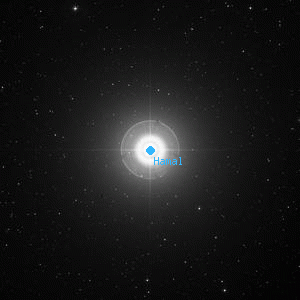Hamal

Overlaid DSS image of Hamal, 60' x 60' with north at top and west to the right
Aladin viewer for the region around Hamal
Alpha Arietis, α Ari, 13 Ari
BD+22 306, HD 12929, HR 617, SAO 75151, GSC 01758-02416, HIP 9884
BD+22 306, HD 12929, HR 617, SAO 75151, GSC 01758-02416, HIP 9884
| Type | Star |
|---|---|
| Magnitude | 2.01 | Right Ascension | 2h 7' 10.4" (2000) |
| Declination | 23° 27' 45" N |
| Constellation | Aries |
| Classification | K2-IIIbCa-1 |
Observing Notes
Andrew Cooper
Feb 19, 2020 Waikoloa, HI (map)
20cm f/6 Newtonian, Cave Astrola @ 61x
Seeing: 7 Transparency: 6 Moon: 0%
Orange, bright, no companion noted
Captain William Henry Smyth
Feb 6, 1835 No. 6 The Crescent, Bedford, England (map)
150mm f/17.6 refractor by Tully 1827
A standard Greenwich star, on the Ram's os frontis. A 3, yellow; B 11, purple. The large star is followed by three small ones, forming a line across the parallel, of which the middle individual is B. The primary has a sensible proper motion in space, and the following amount has been registered:P.... RA +0".20 Dec. -0".20Though this constellation only possesses stars of more interest than magnitude, it opened the astronomical year, 2000 years ago, as Princeps signorum and Ductor exercitûs zodaici; and bore the office for a similar period. The charge is now resigned to Pisces, for Aries has passed 30 to the eastward of the point where the equinoctial is intersected by the ecliptic, or Via Solis. This is owing to the precession of the equinoxes, which apparent motion of the zodiac arises from a slow vibration of the earth's axis, occasioned by planetary attraction.
B.... +0".24 -0".12
A.... +0".22 -0".14
[Hipparcos +0".18855 -0".14808]
Thomas Hood, the Fellow of Trinity College, Cambridge, who published directions for using the celestial globe, in 1590, —and who considered the Triangle as only placed in the heavens in order that the head of Aries might be better known —thus speaks of its first star:Scholar. Why is that same starre placed so farre from the head of Aries? me thinketh it were good to keepe the figure and the signe together.Aries indicates the golden fleece of the adventurous crew of the Argo, albeit a stir has been made to identify him as Abraham's ram; and he is recognisable by three stars crossing the head obliquely. Hevelius refers those who wish to be familiar with the different appellations of signs and stars, to the works of Blævius, Alsted, Ricciolus, Goldemayer, Bartschius, and Cellarius; and says he selected the name mostly used "non attento, quod Aries nonnunquam etiam Vervex, Chrysomalus, Jupiter Ammon, Krios. Aribib, Elhemal, et Elhamel, &c. vocetur." The Ram has long been figured in his present attitude, for Manilius accurately describes him as advancing stern foremost, with his legs bent under.
Master. That cannot be; for the starres moving continually from the west towards the east, cannot keepe one and the same distance from the vernall equinoetiall point, but are carried on forward continually, so that the starres which are now in the signe Aries will be hereafter in Taurus, and from thence will come into Gemini" &c.First Aries, glorious in his golden wool,And it is so represented upon the Farnese globe : yet the erudite Bishop of Avranches insists, that the ancients made him running and looking towards the west, or before him. The star under discussion was called Hamal, by the Arabs, i.e. a sheep. It was also named Al nátih, the butt-er, by those who considered the first Lunar Mansion as formed by α and β Arietis. A line made to pass between the Pleiades and Hyades, from Alpherat, will pick up Hamal in the mid-distance, and pass through the Ram's flank; it may also be identified by the brackish rhymes:
Looks back, and wonders at the mighty bull.From Has Mothallath shoot a ray,The stars of Aries have been thus enumerated:
in a south-following line,
And where expand huge Cetus' jaws,
to gamma let it join;
One-fourth the distance thus expressed
from Triangle to Whale,
(If thus can such odd fish be termed,)
will strike upon Hamal.Ptolemy . . . .18 stars Hevelius . . . . 27 starsAn attempt has been made to bring forward a numismatic evidence of the Roman regard for this sign, by citing a coin of Domitian bearing the Ram as Princeps Juventutis. But I am not aware that such a symbol was ever struck; though the aureus with that legend, and the Amalthean goat in a garland, is common enough. Astrologers distinguished it as an equinoctial, cardinal, and diurnal sign —the day-house of Mars —of the fiery triplicity —and what not.
Tycho Brahe . .21 Flamsteed . . . 66
Kepler . . . .23 Bode . . . . . .148― A Cycle of Celestial Objects Vol II, The Bedford Catalogue, William Henry Smyth, 1844
Other Data Sources for Hamal
Nearby objects for Hamal
10 objects found within 120'
| IC 1764 | IC 180 | IC 181 |
| IC 189 | IC 190 | Kappa Arietis |
| NGC 776 | UGC 1547 | |
| UGC 1561 |
Credits...
Drawings, descriptions, and CCD photos are copyright Andrew Cooper unless otherwise noted, no usage without permission.
A complete list of credits and sources can be found on the about page
Hamal